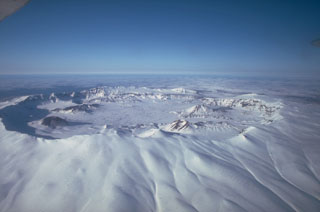Report on Okmok (United States) — November 1987
Scientific Event Alert Network Bulletin, vol. 12, no. 11 (November 1987)
Managing Editor: Lindsay McClelland.
Okmok (United States) Minor ash emission; possible cone growth
Please cite this report as:
Global Volcanism Program, 1987. Report on Okmok (United States) (McClelland, L., ed.). Scientific Event Alert Network Bulletin, 12:11. Smithsonian Institution. https://doi.org/10.5479/si.GVP.SEAN198711-311290
Okmok
United States
53.43°N, 168.13°W; summit elev. 1073 m
All times are local (unless otherwise noted)
Minor eruptive activity from a cone in the SW part of the caldera was observed at 1410 on 16 November by airplane pilots Dave Holman and Jay Brown (Coast Guard). Steam with some ash rose to ~2,100 m altitude and a thin plume drifted 20 km ENE at 1,500-2,100 m altitude. [On 1 December] at 1300 and 1510, pilot T. Madsen (Aleutian Air) observed a light gray plume drifting 25 km ESE at 1,200 m altitude. He also noted that the cone appeared to be higher than the caldera rim (900-950 m elevation), indicating that it had grown since he last saw it over a month ago.
Geological Summary. The broad, basaltic Okmok shield volcano, which forms the NE end of Umnak Island, has a dramatically different profile than most other Aleutian volcanoes. The summit of the low, 35-km-wide volcano is cut by two overlapping 10-km-wide calderas formed during eruptions about 12,000 and 2050 years ago that produced dacitic pyroclastic flows that reached the coast. More than 60 tephra layers from Okmok have been found overlying the 12,000-year-old caldera-forming tephra layer. Numerous satellitic cones and lava domes dot the flanks of the volcano down to the coast, including 1253-m Mount Tulik on the SE flank, which is almost 200 m higher than the caldera rim. Some of the post-caldera cones show evidence of wave-cut lake terraces; the more recent cones, some of which have been active historically, were formed after the caldera lake, once 150 m deep, disappeared. Hot springs and fumaroles are found within the caldera. Historical eruptions have occurred since 1805 from cinder cones within the caldera.
Information Contacts: J. Reeder, Alaska Division of Geological and Geophysical Surveys (ADGGS).

